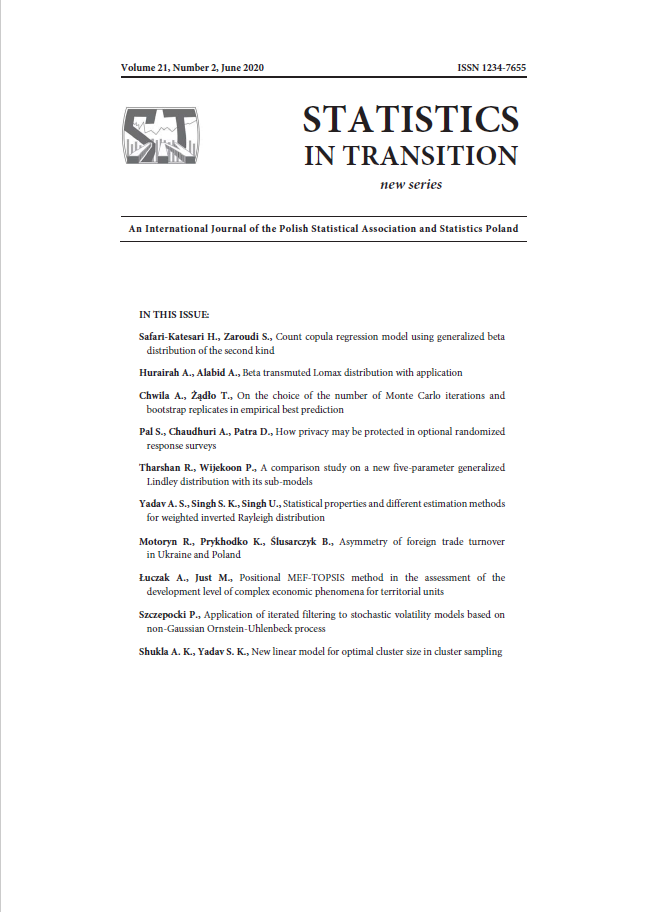ARTICLE
ABSTRACT
In this paper, a nonlinear model is proposed for improving the relationship between the size of a cluster and the variance within the cluster. This model describes the most appropriate functional relation between the within-cluster variance and the cluster size. Through this model, we can obtain the optimum size of a cluster and an estimate of the variance between clusters. The proposed model leads to further improvement in the estimation of the optimum size of a cluster, and the formula for the determination of optimum cluster size leads to explicit solution of models.
KEYWORDS
Non-linear models, optimum cluster size, four-parameter model, variance function
REFERENCES
DRAPER, N. R., SMITH, H., (1998). Applied regression analysis. 3rd Ed., John Wiley & Sons,.
GUJARATI, D. N., SANGEETHA, (2007). Basic Econometrics, 4th Ed, Tata McGraw- Hill.
HANSEN, M. H., HURWITZ, W. N., (1942). Relative efficiencies of various sampling units in population enquiries, Journal of American Statistical Association, 37, pp. 89-94.
JESSEN, R. J., (1942 (). Statistical investigation of sample survey for obtaining farm facts, Iowa Agricultural Experiment Station, Research Bulletin, p. 304.
KAPLAN, S., GURCAN, E. K., (2018). Comparison of growth curves using non-linear regression function in Japanese quail, Journal of Applied Animal Research, 46, 1, pp. 112-117.
LAWSON, N., SKINNER, C., (2017). Estimation of a cluster-level regression model under nonresponse within clusters, Metron, 75, pp. 319-331.
MAHALANOBIS, P. C., (1940). A sample survey of acreage under jute in Bengal, Sankhya, 4, pp. 511-530.
MAHALANOBIS, P. C., (1942). General report on the sample census of area under jute in Bengal, Indian Central Jute Committee.
MISRA, G. C., YADAV, S. K., SHUKLA, A. K., RAJ, B., (2010). Use of a non-linear model for improved estimation in cluster sampling, Journal of Reliability and Statistical Studies, 3, 2, pp. 73-78.
MONTGOMERY D. C., PECK E. A., VINING G. C., (2012). Introduction to Linear Regression Analysis, 5th Ed., Wiley.
RIAZOSHAMS, H., MIDI, H., GHILAGABER, G., (2019). Robust Nonlinear Regression: with Applications using R, 1st Ed, Wiley.
SCARNECIU, C. C., SANGEORZAN, L., RUS, H., SCARNECIU, V. D., VARCIU, M. S., ANDREESCU, O., SCARNECIU, I., (2017). Comparison of linear and nonlinear regression analysis to determine Pulmonary Pressure in Hyperthyroidism, Pakistan Journal of Medical Sciences, 33, 1, pp. 111-120.
SINGH, D., CHAUDHARY, F. S., (2009). Theory and Analysis of Sample Survey Designs, New Age International.
SMITH, H. F., (1938). An empirical law describing heterogeneity in the yields of agricultural crops, Journal of Agricultural Science, 28, pp. 1-23.
SUKHATME, P. V., SUKHATME, B. V., SUKHATME, S., ASOK, C., (1984). Sampling theory of surveys with applications, Indian Society of Agricultural Statistics.
SHUKLA, A.K., YADAV, S. K., (2016). Asymptotic Non-Linear Models for Uniformity Trial Experiments, Elixir International Journal, 94, 1, pp. 40042-40044.
SHUKLA, A. K., YADAV, S. K., MISRA, G. C., (2013). A Linear Model for Uniformity Trial Experiments, Statistics in Transition-new series, 14, 1, pp. 161-170.
TIWARI, R. B., MISRA, G. C., (2011). Estimation of optimum cluster size, IFRSA’s International Journal of Computing, l, 4, pp. 717-722.
ZAKKULA G., (1999). Elements of Sampling Theory and Methods, Printice Hall Publication.
